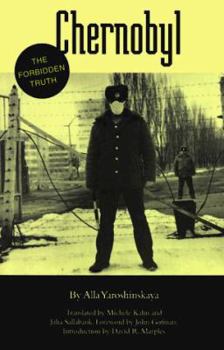Chernobyl: The Forbidden Truth
Select Format
Select Condition 
Book Overview
In this impassioned, shocking, and deeply personal story, Alla Yaroshinskaya, then a journalist from Zhitomir, Ukraine, near the Chernobyl power station, describes the 1986 Chernobyl disaster and the bureaucratic and scientific corruption surrounding it. Despite the government's official silence, news and panic spread throughout the USSR and Europe after the horrific accident. ? Like others, Yaroshinskaya initially fled with her family in hopes of escaping the danger from radioactive fallout that exceeded that of Hiroshima by three hundred times. When she returned home, she discovered that people in highly contaminated areas were being resettled in ones barely less contaminated, that their serious health problems were officially denied, and that people had to eat locally grown contaminated food. ? Her newspaper refused to publish her stories and instead commissioned another journalist to write more reassuring accounts. Finally, Isvestia published her articles. Despite official pressure, Yaroshinskaya was nominated overwhelmingly to the new parliament in 1989. This position gained her access to classified documents know as the Kremlin's "Forty Secret Protocols." Undaunted by threats, she revealed an official cover-up, including lies about "permissible" higher radioactive levels. Her courageous campaign won her the Right Livelihood Award in 1992.
Format:Paperback
Language:English
ISBN:0803299109
ISBN13:9780803299108
Release Date:January 1995
Publisher:Bison Books
Length:136 Pages
Weight:2.05 lbs.
Dimensions:0.4" x 5.9" x 8.9"
Customer Reviews
3 ratings
The inside story
Published by Thriftbooks.com User , 16 years ago
This book contains the best description yet of what exactly happened at Chernobyl. In contrast to the fuzzy antitechnological nonsense of the mass media, the author identified the cause of the problem: human error. An individual who had the appropriate civil service rank was appointed director of the facility, even though he had no understanding of a nuclear reactor, and had never worked at a nuclear power plant. (The bulk of his experience was in large transformers for long-distance power lines.) He simply marched in and demonstrated his authority by giving orders to the reactor operators until he had created a meltdown. By the time that the district manager arrived - horrified - and took over, the damage was done. This basically parallels the experience at Three Mile Island, where the "suits" harassed the operators into geting the plant online (several months before it should have been) before a certain deadline, in order to satisfy the depreciation rules in the tax code. The technology is perfectly safe; the danger is in allowing poorly educated jerks to be in charge.
Response to another reviewer's comments about the foreward
Published by Thriftbooks.com User , 26 years ago
Chernobyl: The Forbidden Truth is about the inadequate care of the victims of Chernobyl, the inadequate immediate response to the accident, the inadequate records-keeping of the investigaters, and the continuing cost in human and animal suffering caused by this tragedy. Dr. Gofman's foreward is an important addition that ties the book's litany of problems together with a description of what should be done instead regarding investigating the exact size of the calamity. Millions of Curies of various radioactive substances were released (some long-lived, some not so long-lived), but no one really knows where it all went and who is absorbing a dose right now. This is, however, a chronic problem with nuclear activities around the world, and not limited to Chernobyl.In particular, Gofman's NINE ESSENTIAL RULES OF INQUIRY should be required reading for everyone involved in such research. It outlines important requirements for all such testing. Gofman is a Professor Eme! ritus of Medical Physics at the University of California at Berkeley. He is a co-discoverer of Uranium-233 and isolated the world's first "working quantities" of plutonium at Robert Oppenhiemer's personal request for the Manhattan Project during WWII. Since that service to America he has continued to research radiation and its effect on human health and is referred to as "brilliant" by even his adversaries.His comments belong not only in the foreward of this important book, but they also belong pasted to the desks of every nuclear scientist who ever tried to answer the question of just how low a level of radiation is actually "safe".Perhaps if/when they find an answer to that question Gofman's comments will no longer apply, but that day appears to be far off, when our best "research event" ever in the field of human radiation experiments (at least, the best "research event" since Hiroshima and Nagasaki) is as poorly han! dled as it was -- and is -- being handled, as is made clear! in Alla Yaroshinskaya's monumental book.
Great story of human side of the disaster. Flawed Forward.
Published by Thriftbooks.com User , 27 years ago
Ms. Yaroshinskaya's telling of her struggle to publish the truth about the Chernobyl disaster ranks among the best of this type. Very good, very true story. Well translated. The forward by John Gofman is a self praising, out-of-place, anti-nuclear discussion on how to conduct a type of research. The book would have been improved by its omission.






